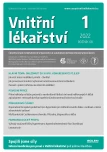Differential diagnosis of pituitary enlargement
Authors:
Katarína Štěchovská 1; Tomáš Tůma 2; Václav Masopust 3; Mikuláš Kosák 1
Authors‘ workplace:
Ústřední vojenská nemocnice, Interní klinika 1. LF UK a ÚVN, Praha
1; Ústřední vojenská nemocnice, Radiodiagnostické oddělení, Praha
2; Ústřední vojenská nemocnice, Neurochirurgická a neuroonkologická klinika 1. LF UK a ÚVN, Praha
3
Published in:
Vnitř Lék 2022; 68(1): 58-63
Category:
Differential Diagnosis Column or What You Can Be Asked at a Postgraduate Certification Exam
Overview
Enlargement of the pituitary gland is heterogenous in the etiology. Common causes of pituitary enlargement are physiological hypertrophy during pregnancy, primary and secondary tumors, autoimmune hypophysitis including side effects of anticancer therapy with check-point inhibitors. Terms like hypertrophy, hyperplasia, sellar expansion and hypophysitis are commonly used to describe enlargement of the pituitary gland on MR scan regardless its etiology.
The most common pathology causing pituitary gland enlargement is pituitary adenoma. Magnetic resonance imaging can differentiate pituitary tumors from diffuse enlargement due to hypophysitis in most but not all cases. Changes on imaging during time or response to pharmacotherapy might help determine the final diagnosis in uncertain cases.
We present a case report of a young woman with sellar expansion due to prolonged untreated peripheral hypothyroidism mimicking pituitary adenoma. Interdisciplinary cooperation of endocrinologist, radiologist and neurosurgeon is crucial in determining the diagnosis.
Keywords:
Hypothyroidism – hypophysitis – immune checkpoint inhibitors – pituitary tumor – sellar expansion
Sources
1. Osborn AG, Salzman KL, Jhaveri MD et al. Diagnostic imaging Brain, 3rd ed. Elsevier: 2010: 1060-62. ISBN 978-0-323-37754-6.
2. Bonneville JF, Cattin F, Nagi S et al. MRI of the Pituitary Gland. Springer: 2016: 53-55. ISBN 978-3-319-29043-0.
3. Hána V. Hypopituitarismus a diabetes insipidus centralis: průvodce ošetřujícího lékaře. In: Hugo J.Farmakoterapie pro praxi. Maxdorf: Praha:2011:10–21. ISBN 978-80-7345-241-4.
4. Horvath E, Kovacs K, Scheithauer BW. Pituitary hyperplasia. Pituitary 1999;1:169-79.
5. Marek J. Hypofýza a její onemocnění. Sanquis 2005;40:24.
6. Netuka D, Masopust V, Beneš V. Léčba adenomů hypofýzy. Cesk Slov Neurol N 2011;74:240-253.
7. Howlett TA, Levy MJ, Robertson IJ. How reliably can autoimmune hypophysitis be diagnosed without pituitary biopsy. Clin Endocrinol (Oxf) 2010;73:18–21.
8. Krarup T, Hagen C. Autoimmun hypophysitis [Autoimmune hypophysitis]. Ugeskr Laeger 2010;172:875-880.
9. Bertrand A, Kostine M, Barnetche T et al. Immune related adverse events associated with anti‑CTLA- 4 antibodies: systematic review and meta‑analysis. BMC Med 2015;13:211.
10. Dillard T, Yedinak CG, Alumkal J et al. Anti‑CTLA- 4 antibody therapy associated autoimmune hypophysitis: serious immune related adverse events across a spectrum of cancer subtypes. Pituitary 2010;13:29-38.
11. Tsoli M, Kaltsas G, Angelousi A et al. Managing Ipilimumab‑ Induced Hypophysitis: Challenges and Current Therapeutic Strategies. Cancer Manag Res 2020; 12: 9551-9561.
12. Caturegli P, Newschaffer C, Olivi A et al. Autoimmune hypophysitis. Endocr Rev 2005;26:599-614.
13. Falorni A, Minarelli V, Bartoloni E et al. Diagnosis and classification of autoimmune hypophysitis. Autoimmun Rev 2014;13:412-416.
14. Bellastella G, Maiorino MI, Bizzarro A et al. Revisitation of autoimmune hypophysitis: knowledge and uncertainties on pathophysiological and clinical aspects. Pituitary 2016;19:625-642.
15. Joshi MN, Whitelaw BC, Carroll PV. Mechanisms in Endocrinology: Hypophysitis: diagnosis and treatment. Eur J Endocrinol 2018;179:151-163.
16. Donadieu J, Rolon MA, Thomas C et al. Endocrine involvement in pediatric‑onset Langerhans‘ cell histiocytosis: a population‑based study. J Pediatr 2004;144:344-350.
17. Joshi MN, Whitelaw BC, Palomar MT et al. Immune checkpoint inhibitor‑ related hypophysitis and endocrine dysfunction: clinical review. Clin Endocrinol (Oxf) 2016;85:331–339.
18. Faje AT, Sullivan R, Lawrence D et al. Ipilimumab‑ induced hypophysitis: a detailed longitudinal analysis in a large cohort of patients with metastatic melanoma. J Clin Endocrinol Metab 2014;99:4078-4085.
19. Min L, Hodi FS, Giobbie‑Hurder A et al. Systemic high‑dose corticosteroid treatment does not improve the outcome of ipilimumab‑ related hypophysitis: a retrospective cohort study. Clin Cancer Res 2015;21:749-755.
20. Ryder M, Callahan M, Postow MA et al. Endocrine‑ related adverse events following ipilimumab in patients with advanced melanoma: a comprehensive retrospective review from a single institution. Endocr Relat Cancer 2014;21:371-381.
21. Angelousi A, Alexandraki KI, Tsoli M et al. Hypophysitis (including IgG4 and immunotherapy). Neuroendocrinology 2020;110:822-835.
22. Larkin J, Chiarion‑Sileni V, Gonzalez R et al. Combined nivolumab and ipilimumab or monotherapy in untreated melanoma. N Engl J Med 2015;373:23-34.
Další literatura u autorů a na www.casopisvnitrnilekarstvi.cz
Labels
Diabetology Endocrinology Internal medicineArticle was published in
Internal Medicine

2022 Issue 1
Most read in this issue
- A cirrhotic patient in an internal medicine ward
- Cholesterol measurement and current guidelines
- Differential diagnosis of pituitary enlargement
- Levotyroxin
